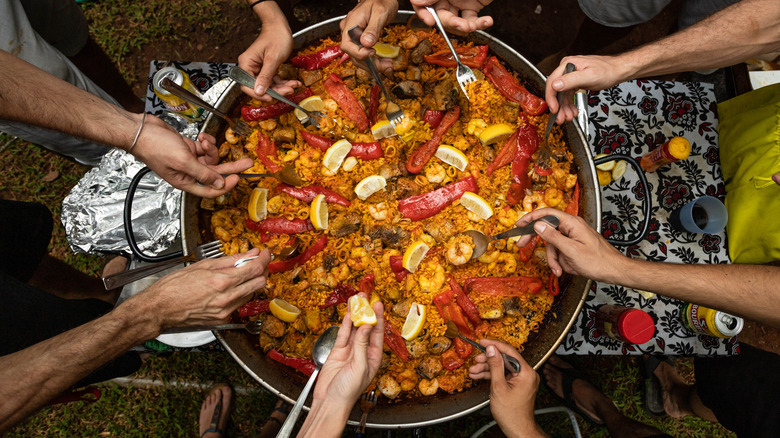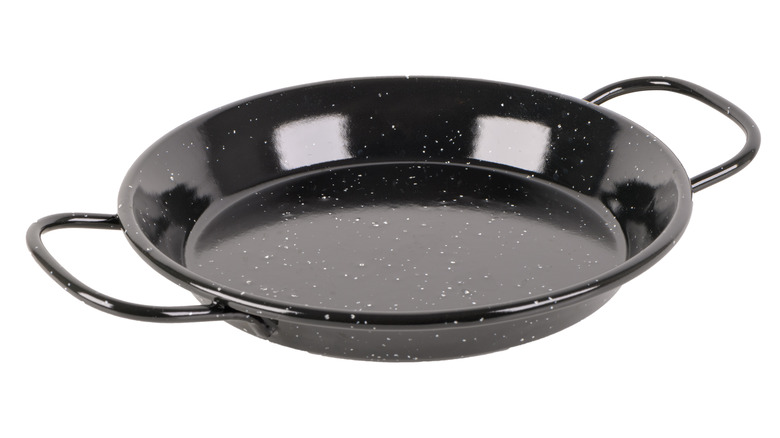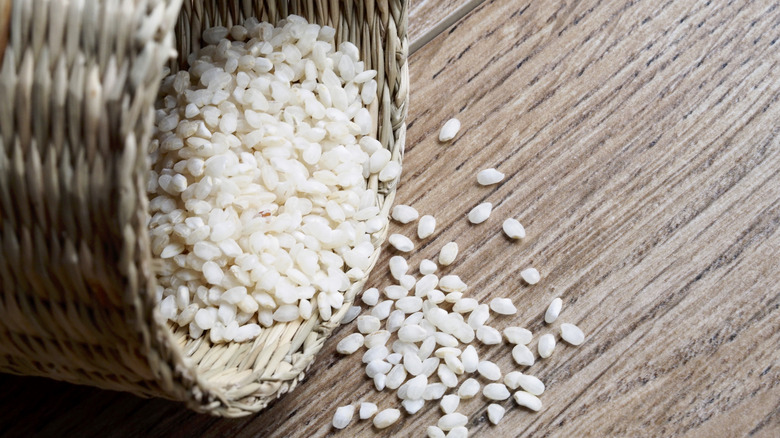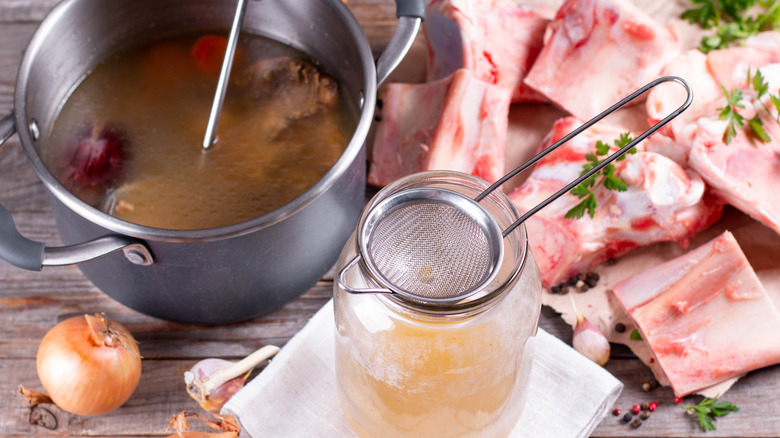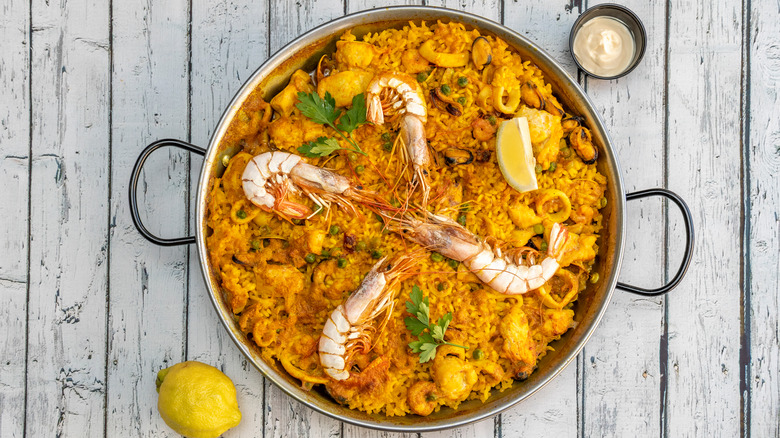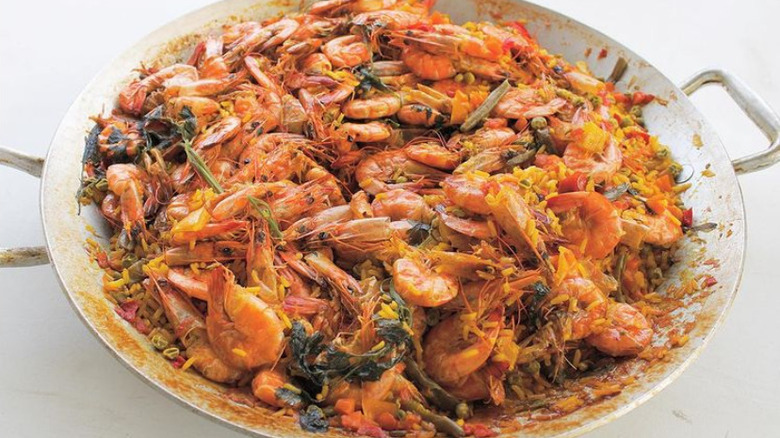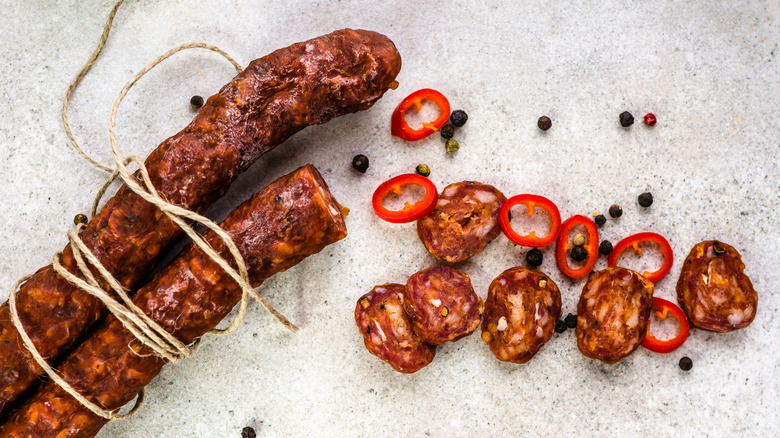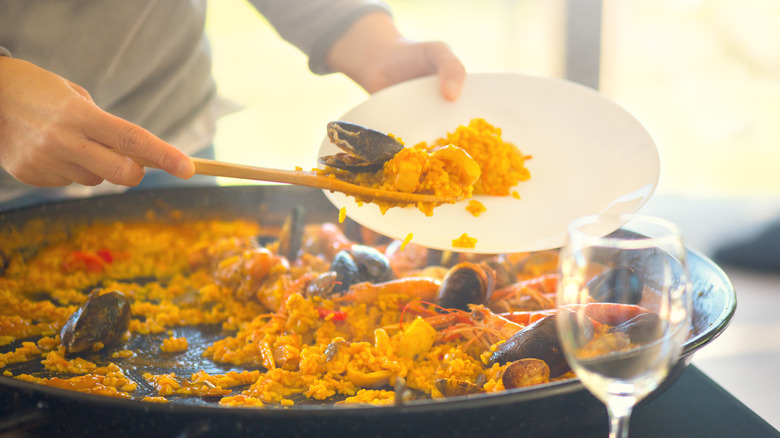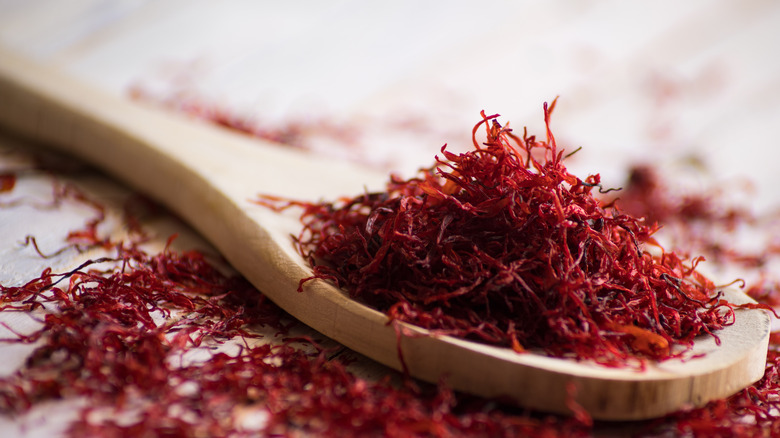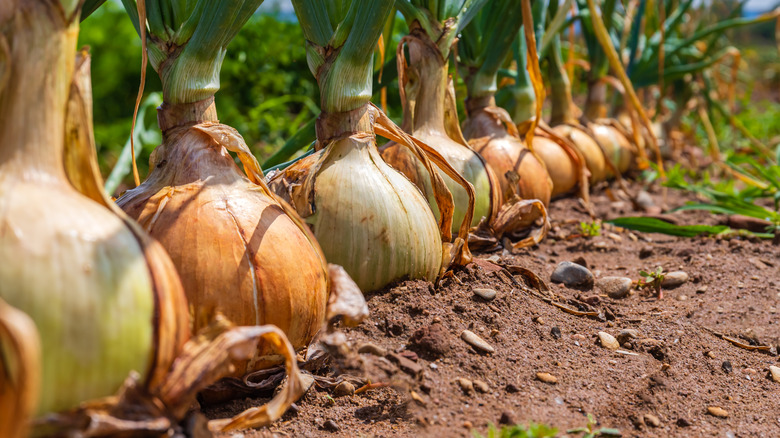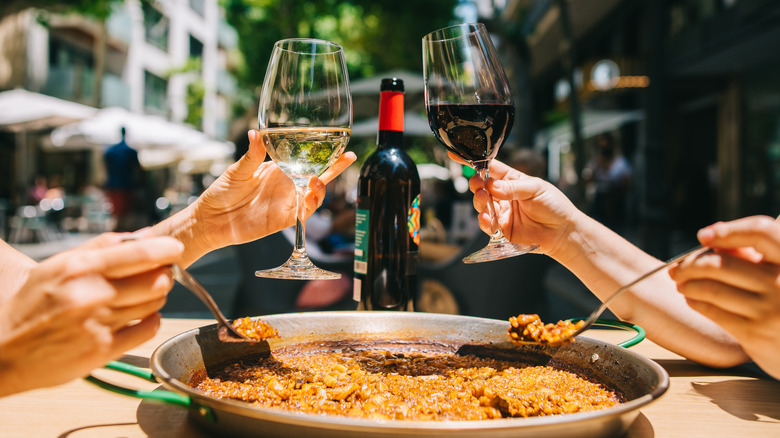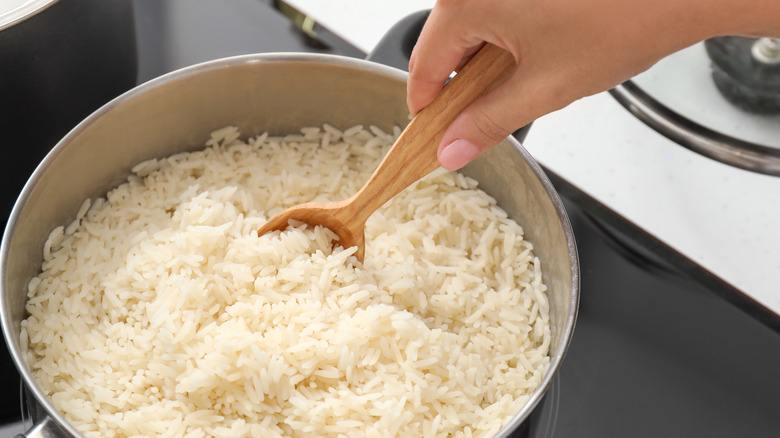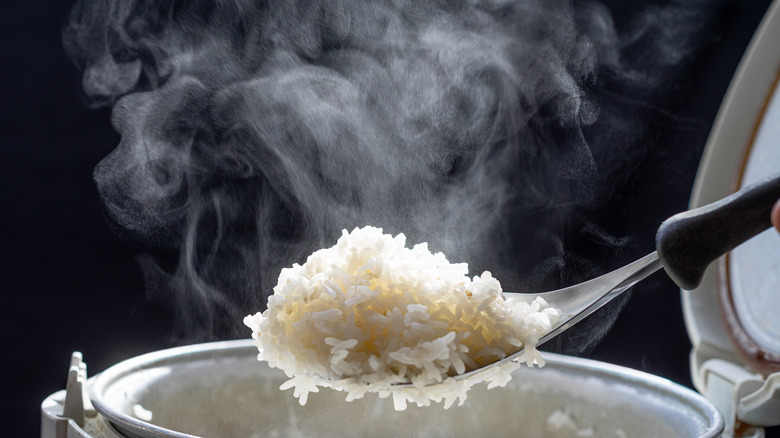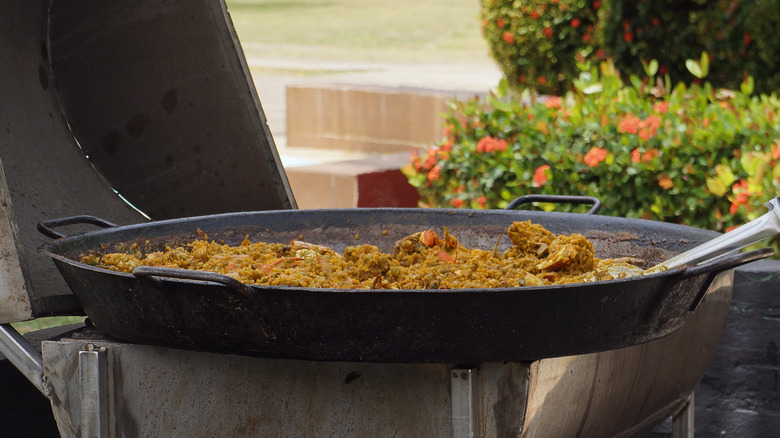Mistakes Everyone Makes When Making Paella
Picture Valencia in spring. The sun beams down on fruiting orange trees as a table and chairs are placed in their generous shade. An open wood-fire is spitting and roaring, adding its heat to the already thick Spanish air. Crackles and pops herald that serving time is near, and when it finally arrives, a great shallow pan is hoisted from the flames and onto the table. Family and friends gather around it, spoons in hand, and before long the sound of satisfied eating and jovial conversation rises from the table.
Paella, when eaten in this manner, is a sight to behold. Not only do the toppings shine upon a bed of muted golden rice, but people gather and converse in a truly communal dining experience. Add to this the dish's subtle flavorings and al dente texture and it is understandable why paella has become a global phenomenon.
Recreating this experience in your own home is very special indeed. However, paella is a dish that is simultaneously extremely difficult to make well and very easy to ruin. Soft mushy rice, overcooked protein, and nonsensical toppings are all simply made mistakes. And whilst avoiding these common errors will not guarantee you the paella of your Castilian dreams, it will go some way in getting you there.
Using the wrong pan
Paella is named after the dish it is made in: a shallow and extremely wide pan, traditionally double-handled and made from steel. The pan has this unique and peculiar shape for a very specific reason — the large surface area allows for a thin layer of rice to be cooked in liquid that evaporates much quicker than in a traditional pot. This unique cooking process is what gives paella its dry, al dente texture.
Trying to make paella without a paella pan is a difficult challenge, but one that is absolutely achievable. According to paella expert and chef Lolo Manso, the best substitutes are a cast iron pan, casserole dish, or frying pan (via InsideHook). However, a paella cooked in the correct pan will nearly always be superior to that cooked with substituted equipment, mainly due to the aforementioned evaporating process.
Indeed, using the incorrect size paella pan will also affect the unique cooking process that is key to making the perfect paella. As rice should be no more than a finger's width deep (per The Splendid Table), overfilling a small paella pan in order to feed more people will turn your potentially perfect paella into a heap of undercooked rice sitting on top of wet, overcooked rice. In order to avoid this all too common occurrence, be sure to only use a paella pan that is the correct diameter for your needs.
Using the wrong type of rice
Rice is a notoriously tricky ingredient to cook. In fact, famous chef and paella aficionado Omar Allibhoy has himself conceded that cooking rice in general, and specifically in paella, is an extremely technical process that relies on water to rice ratios, heat intensities, and of course rice type (via The Splendid Table).
It is widely accepted that to make excellent paella, you must start with the correct type of rice. As reported by The Guardian, medium-grain Spanish rice, the most popular of which is bomba, is the only option. This type of rice is essential due to its absorption qualities. When submerged, bomba rice absorbs three times its volume and will only expand in width (per CooksInfo). This prevents the paella from becoming mushy and allows the rice to absorb the maximum flavor from both the added ingredients and the stock it is cooked in.
Substituting the Spanish-grown varieties for cheaper, more readily available alternatives such as basmati or arborio may severely limit the quality of paella you can produce. However, if you do decide to go down this route, be sure to reduce the quantities of stock used, as longer grain rice varieties, such as basmati, typically only absorb one and a half times their volume (per BBC Good Food).
Not using homemade stock
If rice is the building block of paella, then the stock is its mortar. This liquid will be responsible for filling your rice with flavor and will help determine the final quality of your paella. To put it simply, a poor stock will guarantee a poor paella.
Quique Dacosta, a Spanish chef with three Michelin stars, swears by making his own stock due to the lack of control imparted by store-bought cubes or concentrates (via The Guardian). Boiling the heads and tails of shellfish is an easy way to make a flavorful stock for a seafood paella, while mixing roasted bones with an assortment of vegetables is advised for meat-centric variations. For both stocks, using minimal water is advised as overfilling with water will result in a finished product that is weak and tasteless.
If you decide to use store-bought stock, you can still ensure a flavorsome paella by gently boiling it with some aromatics or bones. This quick process will transform a one-dimensional, store-bought stock into a complex and flavor-filled liquid that will make your rice sing.
Including both meat and fish in the same paella
Much like southern BBQ, paella is a dish that carries a significant amount of cultural importance. So much so, in fact, that the dish has been awarded a special protected status by the Valencian government and labeled as an item of cultural significance (per The Guardian). While preserving paella for future generations is a cause for celebration, such fervent admiration and desire to maintain authenticity means that some versions of paella, no matter how popular, will always be met with disapproving looks.
One such variation is paella mixta, a paella filled with both seafood and meat. This type of paella rose in prominence due to the large influx of British tourists in the 1960s and has since been associated with establishments that cater to tourists and not locals. Despite being celebrated by noted British cookbook author Elizabeth David, this surf-and-turf style heralded the beginning of a dark age for paella (per Roads & Kingdoms) and as such is a combination to be avoided at all costs if creating an authentic paella is your ultimate goal.
Overloading the paella with too many ingredients
Search for paella on Instagram and you will be greeted by the sight of paella pans groaning under the weight of pink shellfish, brightly colored vegetables, and hunks of meat. However, overloading your paella with ingredients is one surefire way to suffocate the rice (per La Paella).
Paella should always be about the gorgeous, al dente, and separate grains of rice that burst with infused flavor, and having too many toppings can detract from the real star of the show. Michelin-starred chef Danny Lledo agrees. Speaking to Food & Wine, Lledo suggested that rice as the protagonist should be supplemented by a few carefully selected ingredients, all of which should have an opportunity to bring their unique flavor to the fore.
Overloading paella is not a problem unique to our times; Colman Andrews, one of the world's foremost experts on Spanish cuisine, penned a heartfelt defense of reservedly-topped paella back in 1989 for the Los Angeles Times. Andrews even went as far as to shame two chefs and their restaurants for adding "superfluous" ingredients to their paellas.
Adding chorizo
Britain does not have the best track record when it comes to culinary endeavors. Yet that doesn't seem to stop the small nation from passing judgment and making alterations to other countries' hallowed dishes. Chicken Tikka Masala and the fare served at British Chinese takeaways both serve as direct examples of Britain's penchant for meddling with other cuisines.
Unfortunately, paella has not escaped the Anglo's misguided fingertips, as exemplified by British chef Jaime Olive's inclusion of chorizo in his version of paella. Oliver's announcement of his dish was met with sustained ridicule by Spanish individuals who maintained that adding chorizo to paella was equal to making fish and chips with aubergines and duck.
In case it bears repeating, adding chorizo is a huge no in your endeavor to create a beautiful, authentic paella. Not only will chorizo open you to ridicule by any Spanish national, but the smoky, spiced sausage will also come to dominate the flavor of your paella, negating all the hard work you put into your stock.
Serving the paella on a plate and not in the pan
As with any difficult dish, after you have finished making your paella, it would be natural to stand back, admire your handiwork for a few seconds, and then begin to serve. And while there is absolutely nothing wrong with patting yourself on the back after making your paella, you will be making a grave mistake if you proceed to spoon the delicious rice out of the pan and onto individual plates. This is because spooning the paella out of the pan damages the rice's delicate texture (per La Paella).
Placing the paella in the middle of the table, seating yourselves around it, and eating directly out of the pan is the traditional manner in which paella is eaten. This not only ensures the vitally important communal aspect of the dish is maintained, but ensures that those partaking can scrape off the precious socarrat – the bottommost layer of the paella that is flavorful, crisp, and highly prized.
The lack of plates does not mean an abandonment of manners. Paella aficionados at Wikipaella have put together a tutorial explaining how one should conduct themselves in such a situation. One tip even goes as far as to explain that it is customary to ask your neighbor's permission before squeezing lemon on your section of paella.
Substituting saffron for cheaper alternatives
There are no two ways about it, saffron is expensive. In fact, due to the highly labor-intensive harvesting process, saffron stands as the world's most expensive spice, with 1 pound costing approximately $5,000 (per Business Insider). So it's understandable then that some people would rather avoid adding it to their paella in favor of something a little bit cheaper.
But unfortunately, saffron is absolutely integral to paella, and not only in a traditional sense. Without saffron, paella lacks its central flavor and distinctive golden color. Some common, and less expensive alternatives, included turmeric and tartrazine, a food coloring also used in Mountain Dew. However, using alternatives in your paella is never something that can be recommended. Chef José Pizarro, a man who has been celebrated for bringing authentic Spanish cooking to London, epitomized the general Spanish stance on the matter when speaking to The Guardian, saying "always use proper saffron, never turmeric or colorant — that's sacrilege."
Spotting a paella that has had the saffron substituted is easily done. Both turmeric and tartrazine result in a bright yellow paella, whereas saffron-infused paella is a much gentler orangey-gold.
Putting onions in paella
When a team of social scientists from the Universidad Católica de Valencia produced a list of the 10 official ingredients that can be included in paella, there were some contentious inclusions and exemptions. However, one product that no one lamented being left off the list was onions.
The exclusion of onions may seem strange to those outside Spanish borders. After all, onions often form the basis of not only many dishes but even whole cuisines (per Great British Chefs). However, there is a very good reason these beloved vegetables are not included in paella. According to Majorca Daily Bulletin, onions tend to make the rice soften, causing the paella to lose its signature crunch. This is because fresh onions are composed of 89% water, a significant amount that is sure to throw off your carefully planned rice-to-liquid ratio.
At least if you do decide to add onions to your paella, you can rest assured that you're not alone. In 2013, the popular Catalan beer company Estrella Damm produced a commercial that showed onions being prepared for a party-sized paella. Ever ready to decry an attack on their beloved dish, the Spanish predictably turned on their local company, with the whole fiasco being referred to as "Paellagate."
Making paella for dinner
Spaniards are famed for their slightly irregular eating patterns. Breakfast is often neglected, dinner is usually a light affair eaten around 10 p.m., and lunch is by far the largest and heartiest meal of the day.
For the Spanish then, paella is categorized firmly as a lunchtime meal. It is a dish to indulge in, linger over, and share with family. Consequently, it is a regular fixture of Sunday lunchtimes when whole families can gather and eat before practicing the Spanish art of Sobremesa: when people remain at the table conversing long after the meal has finished. As reported by The Independent, it is nearly unheard of for Spaniards to eat paella during the evening meal, and any restaurant that does serve it at this time is often perceived as catering to tourists. So if you want to enjoy your paella authentically, the way the Spaniards do, save it for a long weekend lunch, complete with as many family and friends as you can fit around the table.
Stirring the rice
Paella has become famous largely due to its unique texture. Dry, individual grains of rice, cooked slightly al dente, stand contrary to other creamy, sticky rice dishes such as risotto. While rice type, stock-to-rice ratio, and cooking methods all play a part in creating paella's delectable texture, there is another ironclad rule that must be followed in order to achieve the perfect paella. This rule is to never, under any circumstances, stir the paella.
There is a very simple explanation behind this counterintuitive advice; the action of stirring damages the surface of the rice, causing it to release starch (per Fine Cooking). This starch thickens any liquid it comes into contact with and can cause the rice and liquid to coagulate. While a rich, creamy sauce might be what you are after when making risotto, it is absolutely the opposite of what you want when making paella.
The mandate to never stir can cause some practical issues. For example, you might wonder how to go about spreading the rice around the pan. Puerto Rican chef Daniel Lugo, when speaking to the Michelin guide, advised sprinkling the rice like salt into the paella pan before shaking it to evenly distribute the grains. Other methods include pouring the rice into the stock in the shape of a cross, before gently spreading with a spatula.
Not cooking the rice properly
A good paella is all about the rice. But just as perfectly cooked rice defines a paella, poorly cooked rice irrevocably dooms it. Both gummy, overcooked rice and hard, inedible rice are a paella's worst enemies. To ensure your rice is cooked to crisp perfection, there are a few common mistakes to avoid.
The majority of us will not be cooking our paella on the traditional open fire, but inside on the stove. This poses an issue, as traditional steel paella pans, due to their poor conductivity, need an even heat source to cook the rice consistently (per Serious Eats). Straddling your paella pan over multiple burners, and rotating it regularly will go some way in negating this issue. But finding a heat source that can fully accommodate your pan should always be the first port of call, even if this means downsizing your pan or purchasing a specific paella burner.
Another common mistake made when cooking paella is to cover it. The steam that is trapped does ensure that the rice will be sufficiently cooked, and therefore is a method favored by less confident cooks. However, steaming the rice will cause the paella to lose its unique texture and as such should be avoided wherever possible.
Finally, the paella must be cooked over extremely high heat to ensure the socarrat develops. This layer of almost burnt rice is essential to paella and one cooked without it will be found lacking in both texture and flavor.
Not leaving the paella to rest before eating
In the exciting pursuit of perfect paella, many overlook the final crucial step of letting the paella rest before eating. These final few minutes, excruciating as they may be, allow all residual moisture to be absorbed by the rice (per Roads & Kingdoms). Not only does resting allow the rice to reach its final, excellent form but it also ensures that the paella, which should have been cooked over searingly high heat, has cooled off enough to eat. Food writer Colman Andrews, author of "Catalan Cuisine," plainly states that "most aficionados of paella prefer it tepid rather than hot" (via The Guardian).
As to the correct resting period, opinions are mixed with most chefs and experts recommending anywhere from five to 10 minutes. In the end, with the aromas wafting around your house, the resting period will more likely than not be dictated by how long you can hold yourself, and others, back from the pan.
